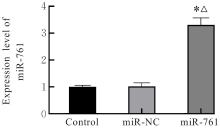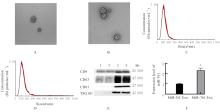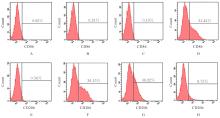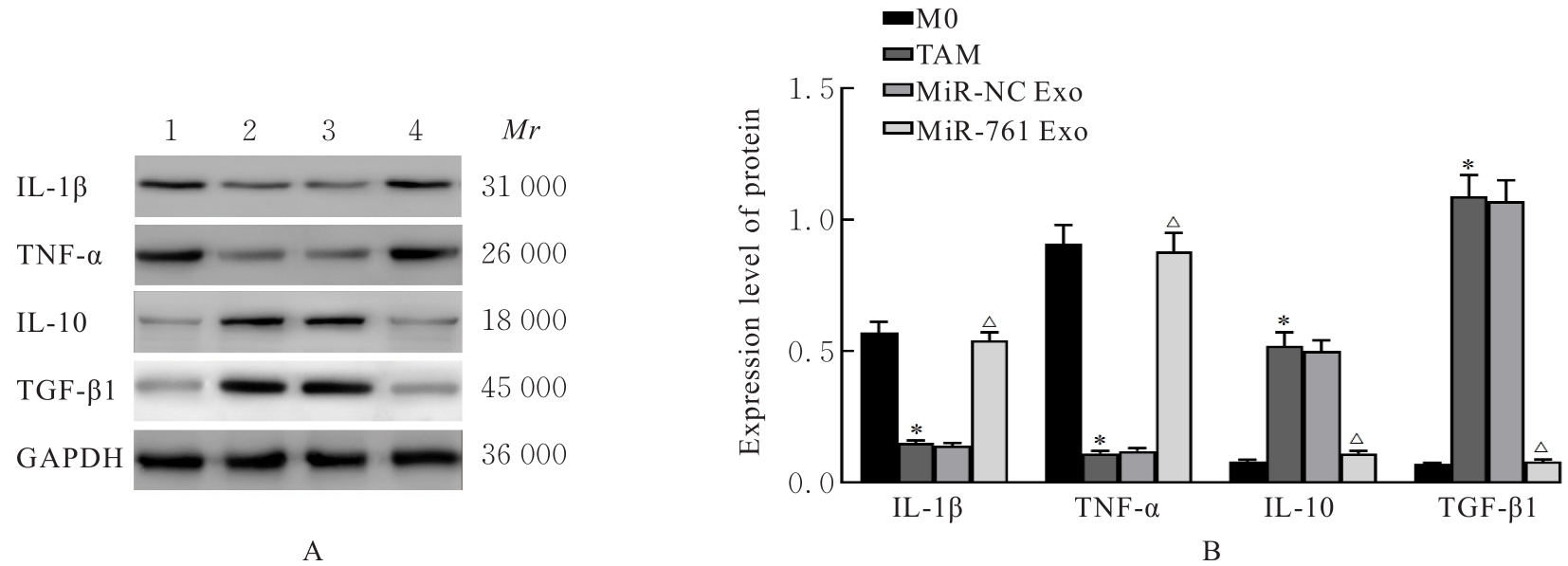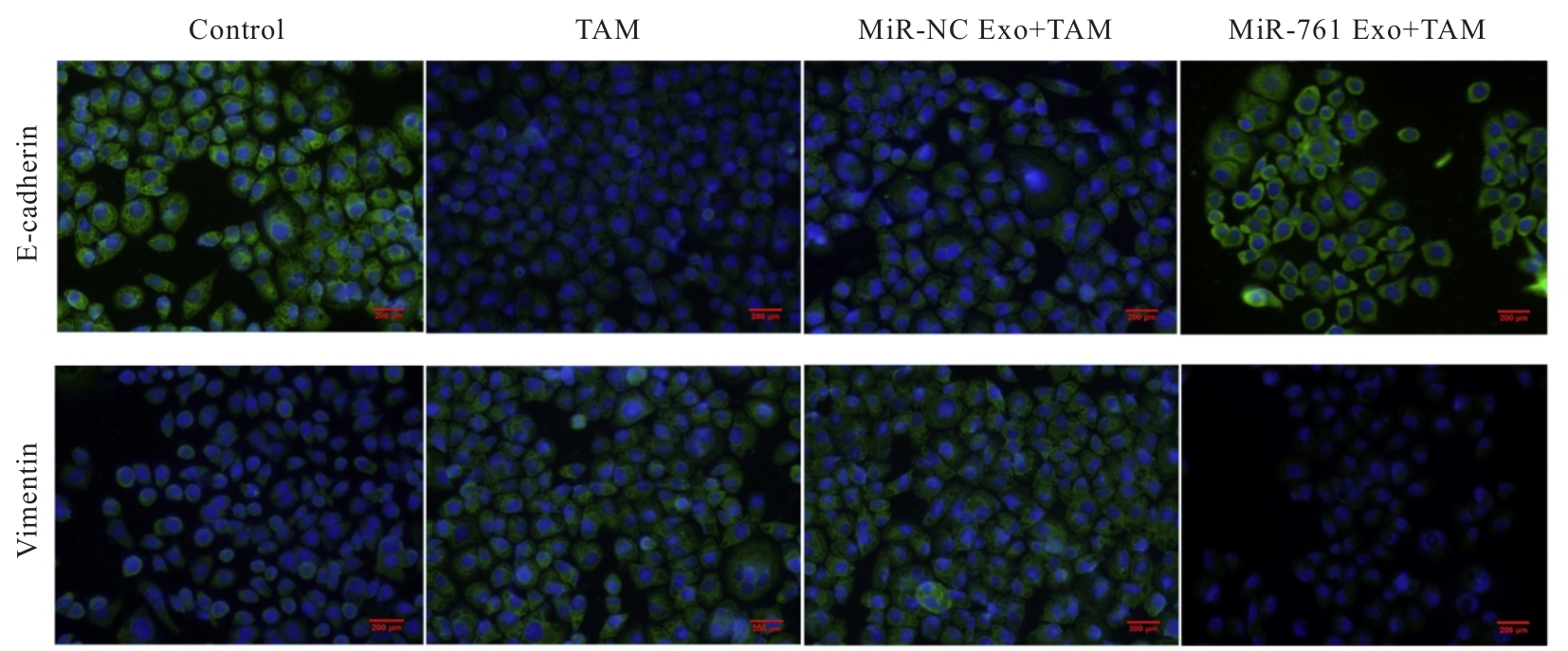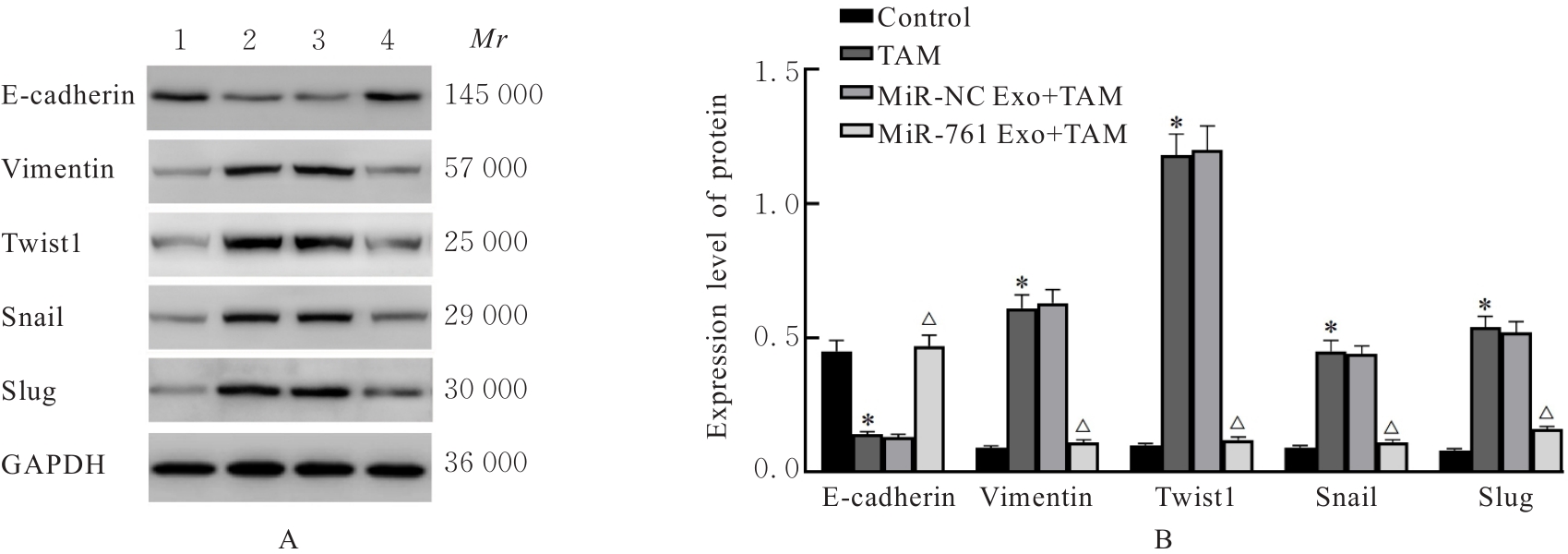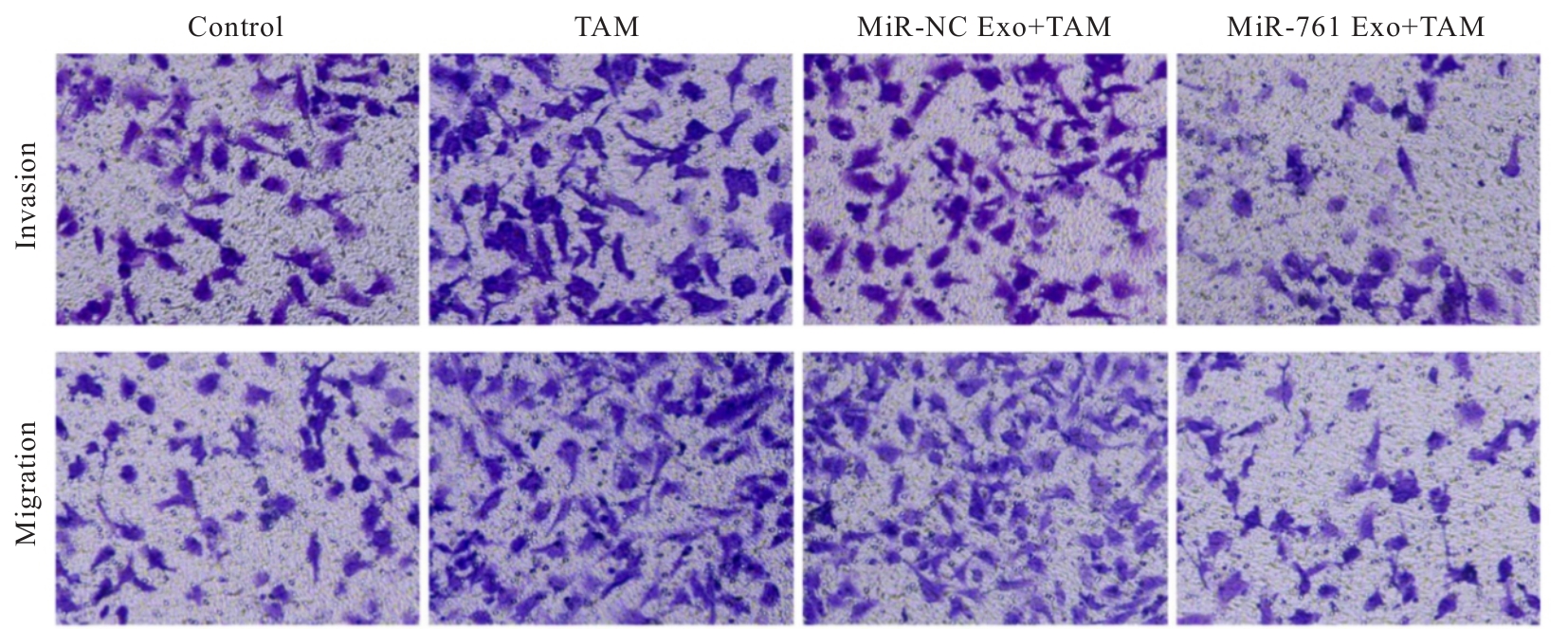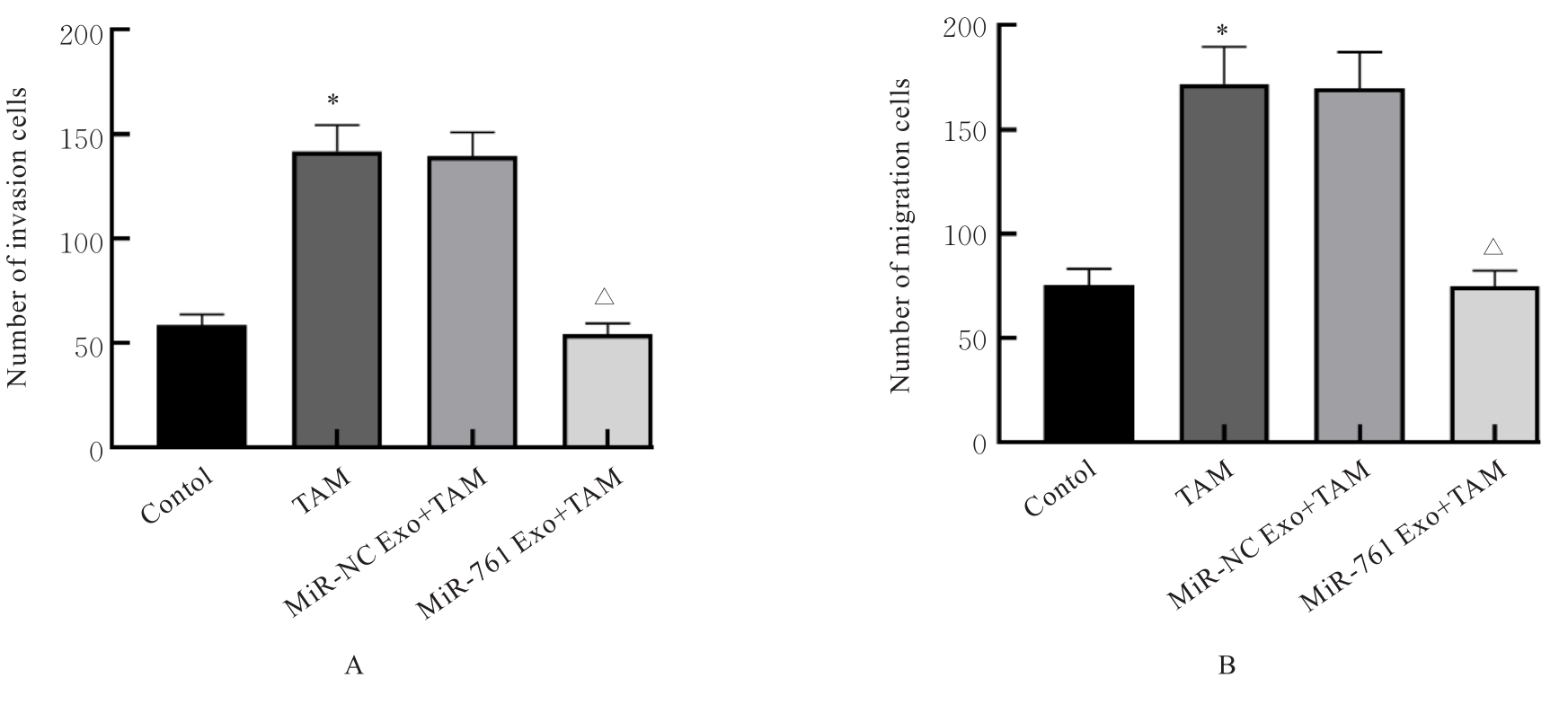Journal of Jilin University(Medicine Edition) ›› 2024, Vol. 50 ›› Issue (4): 978-988.doi: 10.13481/j.1671-587X.20240412
• Research in basic medicine • Previous Articles Next Articles
Effect of miR-761 on epithelial-mesenchymal transition in osteosarcoma MG63 cells by regulating tumor-associated macrophage polarization
Shilei GAO,Jiaqiang WANG,Weitao YAO,Zhichao TIAN,Chao LI,Xiaoxiao LIANG,Xin WANG( )
)
- Department of Bone and Soft Tissue,Affiliated Tumor Hospital,Zhengzhou University,Henan Cancer Hospital,Zhengzhou 450008,China
-
Received:2023-09-18Online:2024-07-28Published:2024-08-01 -
Contact:Xin WANG E-mail:superwx1984@163.com
CLC Number:
- R738.1
Cite this article
Shilei GAO,Jiaqiang WANG,Weitao YAO,Zhichao TIAN,Chao LI,Xiaoxiao LIANG,Xin WANG. Effect of miR-761 on epithelial-mesenchymal transition in osteosarcoma MG63 cells by regulating tumor-associated macrophage polarization[J].Journal of Jilin University(Medicine Edition), 2024, 50(4): 978-988.
share this article
| 1 | BELAYNEH R, FOURMAN M S, BHOGAL S, et al. Update on osteosarcoma[J]. Curr Oncol Rep, 2021, 23(6): 71. |
| 2 | COLE S, GIANFERANTE D M, ZHU B, et al. Osteosarcoma: a Surveillance, Epidemiology, and End Results program-based analysis from 1975 to 2017[J]. Cancer, 2022, 128(11): 2107-2118. |
| 3 | SUN C N, LI S L. PTHR1 in osteosarcoma: specific molecular mechanisms and comprehensive functional perspective[J]. J Cell Mol Med, 2021, 25(7): 3175-3181. |
| 4 | SHOAIB Z, FAN T M, IRUDAYARAJ J M K. Osteosarcoma mechanobiology and therapeutic targets[J]. Br J Pharmacol, 2022, 179(2): 201-217. |
| 5 | ANAND N, PEH K H, KOLESAR J M. Macrophage repolarization as a therapeutic strategy for osteosarcoma[J]. Int J Mol Sci, 2023, 24(3): 2858. |
| 6 | GAZZILLO A, POLIDORO M A, SOLDANI C, et al. Relationship between epithelial-to-mesenchymal transition and tumor-associated macrophages in colorectal liver metastases[J]. Int J Mol Sci, 2022, 23(24): 16197. |
| 7 | DIENER C, KELLER A, MEESE E. Emerging concepts of miRNA therapeutics: from cells to clinic[J]. Trends Genet, 2022, 38(6): 613-626. |
| 8 | CHEN D F, ZHANG B W, CAO J J, et al. Preparation of polycation with hydroxyls for enhanced delivery of miRNA in osteosarcoma therapy[J]. Biomater Sci, 2022, 10(11): 2844-2856. |
| 9 | HAN G, GUO Q Y, LI N, et al. Screening and analysis of biomarkers in the miRNA-mRNA regulatory network of osteosarcoma[J]. J Healthc Eng, 2022, 2022: 8055052. |
| 10 | WANG S Y, ZHANG J Y, CHEN G P, et al. MiR-761 inhibits human osteosarcoma progression by targeting CXCR1[J]. Int J Clin Exp Pathol, 2018, 11(11): 5327-5334. |
| 11 | LAI J J, CHAU Z L, CHEN S Y, et al. Exosome processing and characterization approaches for research and technology development[J]. Adv Sci, 2022, 9(15): e2103222. |
| 12 | 靳 鑫, 倪田根, 王 宁, 等. PGC-1α通过线粒体介导巨噬细胞极化状态的机制研究[J]. 第三军医大学学报, 2019, 41(1): 56-62. |
| 13 | GAO J, LIANG Y Z, WANG L. Shaping polarization of tumor-associated macrophages in cancer immunotherapy[J]. Front Immunol, 2022, 13: 888713. |
| 14 | LI C X, XU X F, WEI S H, et al. Tumor-associated macrophages: potential therapeutic strategies and future prospects in cancer[J]. J Immunother Cancer, 2021, 9(1): e001341. |
| 15 | DUMARS C, NGYUEN J M, GAULTIER A, et al. Dysregulation of macrophage polarization is associated with the metastatic process in osteosarcoma[J]. Oncotarget, 2016, 7(48): 78343-78354. |
| 16 | LIN X B, WANG S Y, SUN M, et al. MiR-195-5p/NOTCH2-mediated EMT modulates IL-4 secretion in colorectal cancer to affect M2-like TAM polarization[J]. J Hematol Oncol, 2019, 12(1): 20. |
| 17 | LI D Z, YAN M, SUN F F, et al. MiR-498 inhibits autophagy and M2-like polarization of tumor-associated macrophages in esophageal cancer via MDM2/ATF3[J]. Epigenomics, 2021, 13(13): 1013-1030. |
| 18 | MA C X, HE D S, TIAN P, et al. MiR-182 targeting reprograms tumor-associated macrophages and limits breast cancer progression[J]. Proc Natl Acad Sci U S A, 2022, 119(6): e2114006119. |
| 19 | SHAO J T, ZARO J, SHEN Y X. Advances in exosome-based drug delivery and tumor targeting: from tissue distribution to intracellular fate[J]. Int J Nanomedicine, 2020, 15: 9355-9371. |
| 20 | 陈瑞婧, 冯韬锦, 程 实, 等. 3D培养人脐带间充质干细胞来源的外泌体对成骨细胞分化的作用[J]. 解放军医学杂志, 2023, 48(4): 411-419. |
| 21 | LIN Y X, XU J X, LAN H Y. Tumor-associated macrophages in tumor metastasis: biological roles and clinical therapeutic applications[J]. J Hematol Oncol, 2019, 12(1): 76. |
| 22 | CHEN X Z, YANG M Q, YIN J, et al. Tumor-associated macrophages promote epithelial-mesenchymal transition and the cancer stem cell properties in triple-negative breast cancer through CCL2/AKT/β-catenin signaling[J]. Cell Commun Signal, 2022, 20(1): 92. |
| 23 | SUN D L, LUO T C, DONG P P, et al. M2-polarized tumor-associated macrophages promote epithelial-mesenchymal transition via activation of the AKT3/PRAS40 signaling pathway in intrahepatic cholangiocarcinoma[J]. J Cell Biochem, 2020, 121(4): 2828-2838. |
| [1] | Bo YUAN,Jiayi XIE,Siyu JIANG,Yajun MENG,Qinghua ZHU,Xiaofei LI,Xiumei FU,Lide XIE. Effect of adipose-derived stem cell-derived exosomes on migration ability of macrophages in vitro [J]. Journal of Jilin University(Medicine Edition), 2024, 50(3): 718-727. |
| [2] | Haifeng WEI,Zhiqiang NI,Yanhong WEI,Qilai WANG,Shouqing LI,Yinfu MA,Yan TAN,Yanqiu FANG. Effects of miR-126 over-expression and ADAM9 gene silencing on biological behavior of gastric cancer SGC-7901 cells and their mechanisms [J]. Journal of Jilin University(Medicine Edition), 2024, 50(2): 310-319. |
| [3] | Tao LIU,Jiacai FU,Chengming ZHONG,Xu TENG,Ling QI. Construction of exosome and AgNPs-loaded antibacterial hydrogel and its effect on proliferation of human epidermal HaCaT cells [J]. Journal of Jilin University(Medicine Edition), 2024, 50(2): 336-345. |
| [4] | Buqi NA,Chunji QUAN,Fang ZHAO,Fan YANG,Ru XIAO,Xuemei JIN,Zhenling LI. Effect of histone deacetylase inhibitor CUDC-101 on DNA damage, migration, and epithelial-mesenchymal transition of prostate cancer DU145 cells [J]. Journal of Jilin University(Medicine Edition), 2024, 50(2): 400-410. |
| [5] | Yanhong WEI,Chenxue YANG,Guangmin YANG,Shuai SONG,Ming LI,Haijiao YANG,Haifeng WEI. Inhibitory effect of downregulating HMGB2 expression on epithelial-mesenchymal transition of liver cancer LM3 cells and its AKT/mTOR signaling pathway mechanism [J]. Journal of Jilin University(Medicine Edition), 2024, 50(1): 143-149. |
| [6] | Jia ZHOU,Zhidong QIU,Zhe LIN,Guangfu LYU,Jiaming XU,He LIN,Kexin WANG,Yuchen WANG,Xiaowei HUANG. Effect of chelerythrine on migration, invasion, and epithelial-mesenchymal transition of human ovarian cancer SKOV3 cells [J]. Journal of Jilin University(Medicine Edition), 2024, 50(1): 25-32. |
| [7] | Tao HE,Zhenjiang LI,Bingqian DING. Influence of ligustrazine on growth of glioma stem cells subcutaneous xenografts in nude mice, TGF-β signaling pathway, and epithelial-mesenchymal transiton [J]. Journal of Jilin University(Medicine Edition), 2023, 49(6): 1437-1444. |
| [8] | Hui YE,Zhe SUN,Liting ZHOU,Wen QI,Lin YE. Bioinformatics analysis on differentially expressed genes in lung adenocarcinoma based on GEO and TCGA Databases [J]. Journal of Jilin University(Medicine Edition), 2023, 49(6): 1491-1503. |
| [9] | Manying OU,Chunxia HU,Yueping LI. Effect of expression of microtubule inhibitory assembly protein 1 in placenta tissue of pre-eclampsia patients on trophoblast cells and its mechanism [J]. Journal of Jilin University(Medicine Edition), 2023, 49(6): 1519-1527. |
| [10] | Xiaolei XUE,Baomei XU. Expression of Klotho protein in placenta exosomes in patients with pre-eclampsia and its effect on oxidative stress in vascular endothelial cells [J]. Journal of Jilin University(Medicine Edition), 2023, 49(6): 1528-1538. |
| [11] | Jiao ZHAGN,Baolian MA,Yonglan ZHANG. Antioxidant capacities of edible plant-exosomes-like nanoparticles in vitro and their protective effects on oxidative damage of PC12 cells induced by hydrogen peroxide [J]. Journal of Jilin University(Medicine Edition), 2023, 49(5): 1117-1124. |
| [12] | Dandan WANG,Ning ZHOU,Dongqin LIU,Jie ZHAO,Chao LIANG,Juanjuan DAI,Yan WU. Effect of miR-491-5p over-expression on proliferation and migration of human nasopharyngeal carcinoma HONE-1 cells [J]. Journal of Jilin University(Medicine Edition), 2023, 49(5): 1134-1139. |
| [13] | Qi WU,Jianfeng CHEN,Hao LI,Feng WEN. Effect of paeonol on proliferation, migration, and CXCR4/STAT3 pathway of human osteosarcoma MG-63 cells [J]. Journal of Jilin University(Medicine Edition), 2023, 49(5): 1202-1209. |
| [14] | Shan LIU,Zhaodong XING,Ping HUANG. Effect of expression of miR-17-5p in exosomes derived from colorectal cancer cells on chemosensitivity of colorectal cancer cells and its mechanism [J]. Journal of Jilin University(Medicine Edition), 2023, 49(4): 975-984. |
| [15] | Rui LI,Xiaodong TAN,Yaoyuan HU. Inhibitory effect of pachylic acid on migration, invasion, and epithelial-mesenchymal transition of human pancreatic cancer PANC-1 cells [J]. Journal of Jilin University(Medicine Edition), 2023, 49(2): 315-323. |
